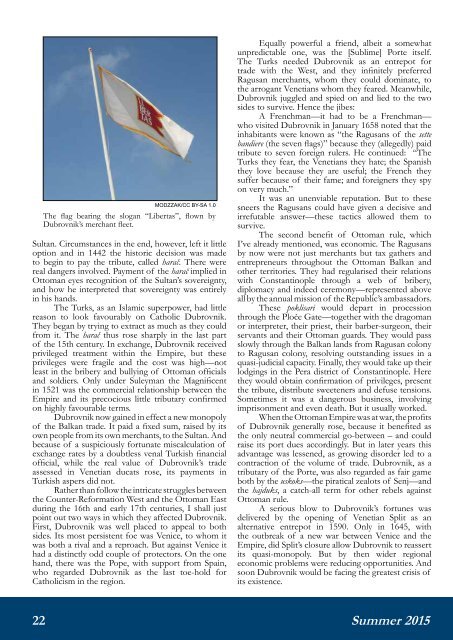CONSERVATIVE
eurocon_12_2015_summer-fall
eurocon_12_2015_summer-fall
- No tags were found...
Create successful ePaper yourself
Turn your PDF publications into a flip-book with our unique Google optimized e-Paper software.
MODZZAK/CC BY-SA 1.0<br />
The flag bearing the slogan “Libertas”, flown by<br />
Dubrovnik’s merchant fleet.<br />
Sultan. Circumstances in the end, however, left it little<br />
option and in 1442 the historic decision was made<br />
to begin to pay the tribute, called harač. There were<br />
real dangers involved. Payment of the harač implied in<br />
Ottoman eyes recognition of the Sultan’s sovereignty,<br />
and how he interpreted that sovereignty was entirely<br />
in his hands.<br />
The Turks, as an Islamic superpower, had little<br />
reason to look favourably on Catholic Dubrovnik.<br />
They began by trying to extract as much as they could<br />
from it. The harač thus rose sharply in the last part<br />
of the 15th century. In exchange, Dubrovnik received<br />
privileged treatment within the Empire, but these<br />
privileges were fragile and the cost was high—not<br />
least in the bribery and bullying of Ottoman officials<br />
and soldiers. Only under Suleyman the Magnificent<br />
in 1521 was the commercial relationship between the<br />
Empire and its precocious little tributary confirmed<br />
on highly favourable terms.<br />
Dubrovnik now gained in effect a new monopoly<br />
of the Balkan trade. It paid a fixed sum, raised by its<br />
own people from its own merchants, to the Sultan. And<br />
because of a suspiciously fortunate miscalculation of<br />
exchange rates by a doubtless venal Turkish financial<br />
official, while the real value of Dubrovnik’s trade<br />
assessed in Venetian ducats rose, its payments in<br />
Turkish aspers did not.<br />
Rather than follow the intricate struggles between<br />
the Counter-Reformation West and the Ottoman East<br />
during the 16th and early 17th centuries, I shall just<br />
point out two ways in which they affected Dubrovnik.<br />
First, Dubrovnik was well placed to appeal to both<br />
sides. Its most persistent foe was Venice, to whom it<br />
was both a rival and a reproach. But against Venice it<br />
had a distinctly odd couple of protectors. On the one<br />
hand, there was the Pope, with support from Spain,<br />
who regarded Dubrovnik as the last toe-hold for<br />
Catholicism in the region.<br />
Equally powerful a friend, albeit a somewhat<br />
unpredictable one, was the [Sublime] Porte itself.<br />
The Turks needed Dubrovnik as an entrepot for<br />
trade with the West, and they infinitely preferred<br />
Ragusan merchants, whom they could dominate, to<br />
the arrogant Venetians whom they feared. Meanwhile,<br />
Dubrovnik juggled and spied on and lied to the two<br />
sides to survive. Hence the jibes:<br />
A Frenchman—it had to be a Frenchman—<br />
who visited Dubrovnik in January 1658 noted that the<br />
inhabitants were known as “the Ragusans of the sette<br />
bandiere (the seven flags)” because they (allegedly) paid<br />
tribute to seven foreign rulers. He continued: “The<br />
Turks they fear, the Venetians they hate; the Spanish<br />
they love because they are useful; the French they<br />
suffer because of their fame; and foreigners they spy<br />
on very much.”<br />
It was an unenviable reputation. But to these<br />
sneers the Ragusans could have given a decisive and<br />
irrefutable answer—these tactics allowed them to<br />
survive.<br />
The second benefit of Ottoman rule, which<br />
I’ve already mentioned, was economic. The Ragusans<br />
by now were not just merchants but tax gathers and<br />
entrepreneurs throughout the Ottoman Balkan and<br />
other territories. They had regularised their relations<br />
with Constantinople through a web of bribery,<br />
diplomacy and indeed ceremony—represented above<br />
all by the annual mission of the Republic’s ambassadors.<br />
These poklisari would depart in procession<br />
through the Ploče Gate—together with the dragoman<br />
or interpreter, their priest, their barber-surgeon, their<br />
servants and their Ottoman guards. They would pass<br />
slowly through the Balkan lands from Ragusan colony<br />
to Ragusan colony, resolving outstanding issues in a<br />
quasi-judicial capacity. Finally, they would take up their<br />
lodgings in the Pera district of Constantinople. Here<br />
they would obtain confirmation of privileges, present<br />
the tribute, distribute sweeteners and defuse tensions.<br />
Sometimes it was a dangerous business, involving<br />
imprisonment and even death. But it usually worked.<br />
When the Ottoman Empire was at war, the profits<br />
of Dubrovnik generally rose, because it benefited as<br />
the only neutral commercial go-between – and could<br />
raise its port dues accordingly. But in later years this<br />
advantage was lessened, as growing disorder led to a<br />
contraction of the volume of trade. Dubrovnik, as a<br />
tributary of the Porte, was also regarded as fair game<br />
both by the uskoks—the piratical zealots of Senj—and<br />
the hajduks, a catch-all term for other rebels against<br />
Ottoman rule.<br />
A serious blow to Dubrovnik’s fortunes was<br />
delivered by the opening of Venetian Split as an<br />
alternative entrepot in 1590. Only in 1645, with<br />
the outbreak of a new war between Venice and the<br />
Empire, did Split’s closure allow Dubrovnik to reassert<br />
its quasi-monopoly. But by then wider regional<br />
economic problems were reducing opportunities. And<br />
soon Dubrovnik would be facing the greatest crisis of<br />
its existence.<br />
22<br />
Summer 2015


